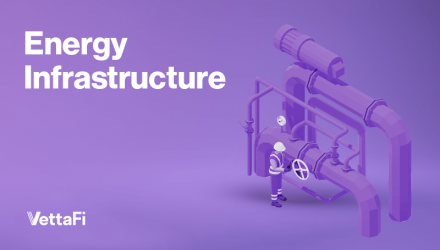Summary
- Under pressure from low prices, overall natural gas production in the US is now expected to decline slightly this year from 2023 levels. The Permian Basin is an exception, expecting steady growth.
- Permian basin natural gas production growth is due to the rising natural gas production from oil wells, known as associated gas.
- Energy infrastructure companies are investing in building incremental transportation and processing capacity, and Permian gas is expected to help meet growing LNG demand.
With natural gas prices falling nearly 30% so far this year from already low levels, some producers are curtailing output, particularly in gas-focused basins. However, the Permian region is still expected to see natural gas production growth in 2024, and midstream companies are investing in transportation and processing capacity for the increased volumes. Today’s note examines natural gas production growth in the Permian Basin and the projects midstream companies are investing in to keep pace.
Permian Gas Production Set to Grow Even as Broader US Gas Production Temporarily Stalls
The weak natural gas price environment so far in 2024 has challenged US producers, which have begun to cut spending in 2024 and curtail production. Curtailments have been relatively minor, but the US Energy Information Administration (EIA) now expects total US natural gas production to decline for the first time since 2020. While the projected decline is minimal—just 0.4% below 2023 levels—it highlights the pressure low prices has put on producers.
Gas production in the Permian basin is largely associated gas or gas produced as a byproduct from oil wells. The Permian has seen steady growth in associated gas over the past decade, with the basin now leading overall US natural gas production growth.
Growing Permian gas production is being driven by both oil production growth and rising gas-to-oil ratios. Gas produced per barrel of oil produced in the top Permian plays has risen from 2 thousand cubic feet per day (Mcf/d) to over 3 Mcf/d. The dynamic has tied natural gas production growth to oil prices, meaning strength in oil prices can contribute to higher natural gas production in the Permian.
With rising output and demand, there is a greater need for incremental natural gas infrastructure in the Permian. There has already been an increase in pipeline takeaway capacity (read more), while rising demand from expanding liquefied natural gas (LNG) capacity on the Gulf Coast should create additional pipeline opportunities for midstream. By 2028, US LNG capacity is set to increase from 13.8 billion cubic feet per day (Bcf/d) to 24.9 Bcf/d along the Gulf Coast (read more).
Midstream Capitalizing on Natural Gas Growth in the Permian
With production growing, midstream companies are investing in additional pipeline transportation capacity from the Permian basin, as well as processing facilities. There is only one newbuild pipeline currently under construction, the Matterhorn Express Pipeline, which is a joint venture between WhiteWater Midstream, EnLink Midstream (ENLC), Devon Energy (DVN), and MPLX (MPLX). The pipeline will transport 2.5 Bcf/d of Permian gas to the Houston area and is expected to be in service in 3Q24.
Two other pipelines recently underwent expansions that went into service in 2023. Kinder Morgan (KMI) expanded its Permian Highway Pipeline by 0.55 Bcf/d, bringing its total capacity to 2.65 Bcf/d. The expansion was placed into service in December 2023. The Whistler Pipeline underwent a 0.5 Bcf/d expansion to 2.5 Bcf/d, which was completed in September 2023.
The Whistler Pipeline is one component of a broader Permian natural gas joint venture (JV) among WhiteWater Midstream, MPLX and Enbridge (ENB). At the end of March, Enbridge (ENB) announced a 19% stake in the JV, alongside the contribution of its Rio Bravo pipeline and cash considerations.
Not all pipeline transportation investment is dedicated to bringing Permian gas to the Gulf Coast. There is also incremental pipeline capacity to Mexico being developed, where rising domestic consumption and a nascent LNG industry are driving demand growth (read more). The largest pipeline project between the US and Mexico is ONEOK’s (OKE) 2.8 Bcf/d proposed Saguaro Connector Pipeline, which would supply Permian gas to Mexico Pacific’s Saguaro LNG facility. The Saguaro Connector Pipeline received approval from the Federal Energy Regulatory Commission in February, and OKE expects to make a final investment decision by mid-year.
The constructive outlook for natural gas on the Gulf Coast is also prompting midstream companies to acquire existing systems. For example, in 4Q23, KMI announced it was acquiring STX Midstream assets from NextEra Energy Partners that includes the Net Mexico gas pipeline for $1.8 billion. The Net Mexico gas pipeline is a 2.2 Bcf/d pipeline from the Agua Dulce hub to the border with Mexico.
In line with pipeline takeaway demands, additional processing capacity for Permian gas is also needed. Enterprise Products Partners (EPD) is currently developing four new natural gas processing plants that will increase capacity by 1.2 Bcf/d. Targa Resources (TRGP) is building three additional gas processing plants that will result in 0.78 Bcf/d of incremental processing capacity. In 2023, TRGP also began operations at a new 0.28 Bcf/d processing plant in the Permian. MPLX is also building two additional gas processing plants that will bring its processing capacity in the Permian to 1.4 Bcf/d.
Bottom Line:
While overall natural gas production in the US is temporarily stalling due to weak prices, the Permian basin is setting up for continued growth. Midstream companies are investing in incremental transportation and processing capacity to handle higher volumes.
Related Research:
Natural Gas Drives Permian Pipeline Growth
Midstream Positions for Ballooning U.S. LNG Exports
MLPs and the Fastest-Growing Hydrocarbon You’ve Not Heard Of
Midstream Connects US Gas With Growing Mexican Demand
For more news, information, and analysis, visit the Energy Infrastructure Channel.

